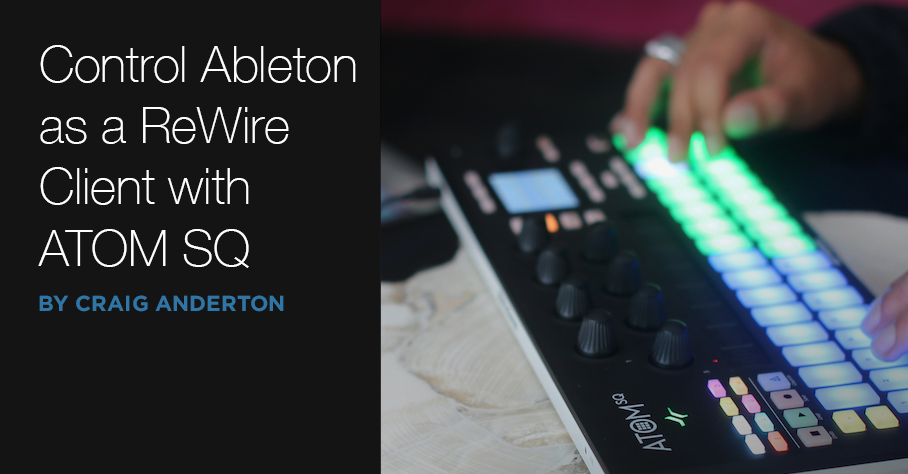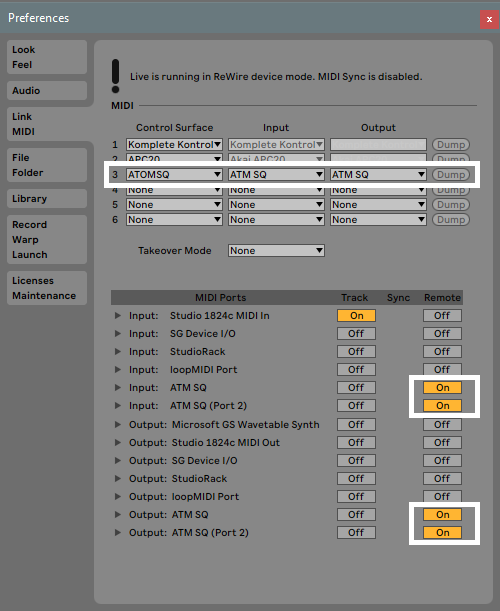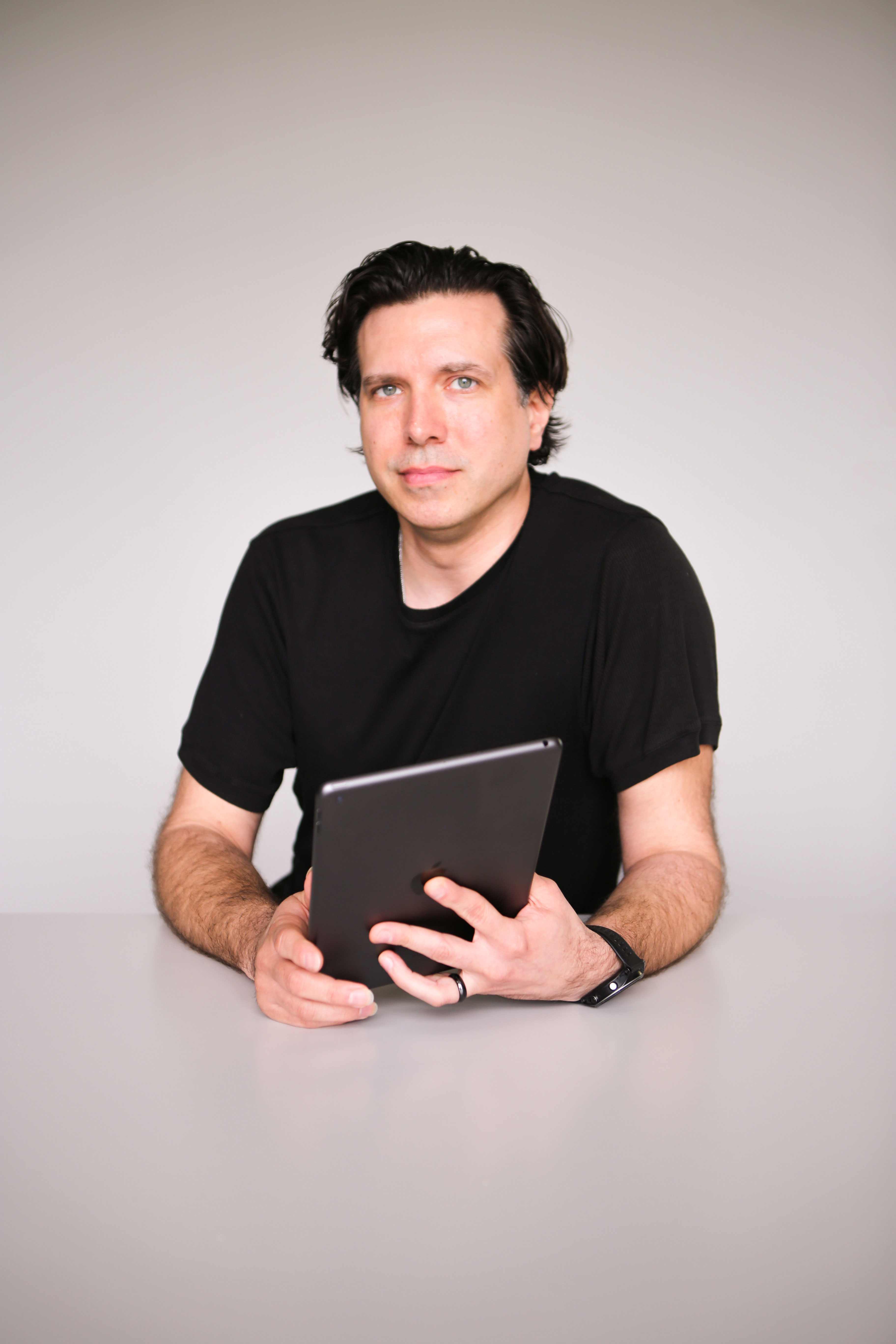Tag Archives: #PreSonus25
Control Ableton as a ReWire Client with ATOM SQ
It’s not surprising a lot of Studio One users also have Ableton Live, because they’re quite different. I’ve always felt Studio One is a pro recording studio (with a helluva backline) disguised as software, while Ableton is a live performance instrument disguised as software.
Fortunately, if you like working simultaneously with Live’s loops and scenes and Studio One’s rich feature set, Studio One can host Live as a ReWire client. Even better, ATOM SQ can provide full native integration with Ableton Live when it’s ReWired as a client—once you know how to set up the MIDI ins and outs for both programs.
Studio One Setup
- Under Options > Advanced > Services, make sure ReWire Support is enabled.
- Insert Ableton Live (from Instruments > ReWire). Click “Open Application” in the dialog box, but if Live won’t open (it doesn’t for me), open Live manually. Note that Live must be version 10.1.15 or higher.
- In Studio One, go Options > External Devices. Click on ATOM SQ, and then click on Edit.
- Select None for both Receive From and Send To. Click OK, then click OK again to leave the Options menu.
- In the ReWire track, set the MIDI input to ATOM SQ so that ATOM SQ’s knobs can control Ableton Live.

Ableton Live Setup
- Choose Options > Preferences > Link MIDI tab.
- Set the MIDI and Ports connections as shown.
Now ATOM SQ will act as an integrated controller with Ableton Live while it’s ReWired into Studio One. Cool, eh?
Returning to Studio One
To return control to Studio One, reverse the process—in Live, set Control Surface to None, and toggle the MIDI Ports that relate to ATOM SQ from On to Off. In Studio One’s Options > External Devices, For ATOM SQ, reconnect ATOM SQ to Receive From and Send To.
Note that with ATOM SQ controlling Studio One, the Transport function still controls both Live and Studio One. Also, if Live has the focus, any QWERTY keyboard assignments for triggering Clips and Scenes remain valid. So even while using ATOM SQ in the native mode for Studio One, you can still trigger different Clip and Scenes in Live. If you switch the focus back to Studio One, then any QWERTY keyboard shortcuts will trigger their assigned Studio One shortcuts.
Note: When switching back and forth between Live and Studio One, and enabling/disabling Studio One and Ableton Live modes for ATOM SQ, to return to Live you may need to “refresh” Live’s Preferences settings. Choose None for the Control Surface and then re-select ATOM SQ. Next, turn the various MIDI Port options off and on again.
PreSonus COO talks Notion, Career and PreSonus!
Here are three cool things you may not know about PreSonus’ notation software Notion.
- Notion was featured in an Apple commercial and photos featured in Apple Stores… True story. Watch the commercial HERE!
- Notion has won several awards, including a prestigious music industry NAMM TEC Award for Best Smartphone/Tablet App.
- Notion has a 4 out of 5 rating in the Apple App Store.
In 2013, we acquired the assets of Notion Music, adding Notion™ music notation and composition software and their other solutions to our product line-up. This innovative product was the first notation app to run on iOS in addition to Mac and Windows, one of the most downloaded music creation apps. Notion and their team were a natural fit in the PreSonus culture of inventive technology development. When PreSonus acquired Notion Music not only did we score an award-winning software, we also got the one and only Jim Boitnott. All year we’re celebrating 25 years of PreSonus so it’s only fitting to celebrate Notion and hear more from one of the creators and current COO of PreSonus Jim Boitnott!
What were you doing before PreSonus?
I was the CEO of Notion Music.
Was owning a business something you dreamed of doing or just fell into it as the products came along?
I never actually owned Notion Music, it was owned by several people and started by Lori and Jack Jarrett. When I was brought in I was in various management positions, and then became CEO. I never dreamed of being a CEO, I just wanted to make a great product that we were proud of. One day after working very hard for years I found myself sitting in that role. I tried to make the best choices I could for our team and customers.
What’s the process of having a great idea to getting it out the door?
This could be a book… There are so many pieces of this massive puzzle no one ever thinks about! Most importantly, commitment from incredibly talented people is crucial. Hard work, focus, and simply finding a way to make it happen. And that’s just getting it out the door… There are many more obstacles after that to make “it” successful.
What need was the Notion intended to meet?
An easy-to-use notation software product with great playback. We always wanted to lead with the sound results, others always lead with the printed results.
At the time, did you have any data supporting the need for this product?
Kind of, but none that would have made a difference. It was more of a “we want to build this and we are” mentality. However, when we released Notion for iPad we did have more data that helped us realize the opportunity. We knew there was a great opportunity for the iPad version and it did pay off with great results, as well as being featured in an Apple ad campaign… one of our proudest moments.
What was the biggest challenge? Major roadblocks?
I’ll be honest, at different times in our company history, it was different issues, such as; ego’s, red tape, lack of experience, internal politics, indecision, cooperation, budgeting, forecasting, etc. It felt like everything at different times, but when it came to making Notion the product, that sometimes felt like the easiest and clearest part. Once we finally got a team that was focused in one direction we were pretty incredible for such limited resources. Then, our biggest roadblocks became time, resources, really good competitors, and market factors.
At the time of its conception, how did you define success?
I think that was part of the problem early on, I think everyone had a different opinion of what success was. Some would have said revenue, others would say a great product, and some were just worried about other things. However, for the first iPad version of Notion, we had a clear goal “Be the first-ever notation app for iOS and make it as solid as the desktop version that it worked alongside of.”
How did you guys come together to build it?
Notion Music from 2003-2013 had some incredible people involved in it, at different times and in different ways. We had people from all over the world come together in Greensboro, NC and created something special. All played a role in getting us where we are today. I was teaching guitar and film scoring classes at Elon University using competitor notation products and then met a co-founder, we randomly struck up a conversation one day. Once she found out I was very knowledgeable with Finale and Sibelius I found myself working at Notion Music just a few weeks later. However, like many businesses, there are highs and lows, and unfortunately, after Notion v2 we had to make some major changes and lost a great number of our team and redesigned the product. The final team, which basically stayed totally intact for the last 5-6 years and all the way through the PreSonus acquisition, were put together based on their versatility, skills, and work ethic. An amazing team: Ben, Chris, Eric, Kyle, Richard, Brian and Brian, Josh, Patrick, Kris, Allison…we all worked hard and had fun.
How did you feel when it was complete?
Like most software products… Notion is not complete, and will never be complete.
When you think about the last 25 years, how does it make you feel seeing how far PreSonus has come?
Just looking at the last 6+ years I have been here it makes me very proud to see what we all have accomplished. The PreSonus team is remarkable, and the stories I have heard about the previous 20 years can go from one extreme to the other. I’ve given responses to those stories like, “How did you even stay in business?” to, “Amazing, how did you accomplish that?”..and of course “Rick did what!?” But looking at 25 years, I’m proud of PreSonus and the amazing team here, and I’m proud of the Notion team that worked through so much adversity to have an opportunity to even be here.
Interested in Notion? Check it out here.
Celebrating 25 years of PreSonus
Let’s take a minute to look at all the firsts PreSonus has had in our first 25 years, from 1995-2020. It’s been quite a ride, and we’ve been glad to have you along for it. In fact, we couldn’t have done it without your support and input. Thanks for taking the trip with us. The next 25? They’re going to be even better.
For a more detailed look at what all we’ve been up to for the past 25 years, and where we hope to go in the future, check out our recently-revised PreSonus History section.
You may have missed some firsts in the video. Here’s the full list:
1995 – Patented MIDI control over analog devices
1996 – the first multi-channel compressor with onboard bus link
1997 – the first stereo analog compressor with presets and manual control
1998 – Invented proprietary IDSS control
2000 – the first 8-channel mic preamp with ADAT output
2002 – The first Analog/Digital recording system over FireWire
2003 – the first rackmount monitoring controller with talkback
2004 – The first FireWire audio interface with eight onboard mic preamps
2005 – the first completely software-controlled audio interface
2006 – the first audio interface with integrated monitor control
2007 – the first single-Fader DAW control surface
2008 – the first digital mixer with continuously bidirectional FireWire interface.
2008 – the first dedicated recording application for a digital mixer
2009 – the first DAW with both recording and mastering
2010 – THE First DAW with direct-to-Soundcloud export
2011 – the first DAW with Melodyne integration
2011 – The first digital mixer control app on the Apple App Store
2012 – the first iPhone monitor mix control app in the App Store
2013 – the first cross-platform integration between software and hardware
2014 – the first powered loudspeaker with Dante™ connectivity
2015 – THE First DAW with cross-platform multitouch support
2016 – the First bi-directional control between a DAW and digital mixer
2018 – the First DAW with real-time pitch control over MIDI and audio
2018 – The first fully-integrated AVB ecosystem
2019 – invented Patent-pending constant directivity loudspeaker design
AND SO MANY MORE
– Patented MIDI control over analog devices
– the first multi-channel compressor with onboard bus link
– Invented proprietary IDSS control to provide manual adjustment over the drain current of an input FET amplifier
– the first 8-channel mic preamp with limiting and A/D conversion to ADAT
– the first Analog/Digital recording system over FireWire
– Invented adjacent filter limiting
– Invented adaptive noise cancellation
– the first rackmount center console monitoring controller with talkback
– the first FireWire audio interface with eight onboard mic preamps
– the first digital sidechain in an analog compressor
– the first solid-state/vacuum tube dual-path mic preamp
– the first audio interface to be networkable over FireWire
– the first completely software-controlled audio interface
– the first audio interface with integrated monitoring remote control
– the first single-fader DAW control surface
– the first FireWire interface for Roland VS hard disk recorders
– the first digital mixer with continuously bidirectional, per-channel FireWire interface
– the first dedicated recording application for a digital mixer
– the first DAW with recording and mastering on the same platform
– the first digital mixer with cascading over FireWire
– the First DAW with direct-to-Soundcloud export
– The first digital mixer control app to be available on Apple App Store
– the first iPad controlled audio interface
– the first iPhone monitor mix control app in the App Store
– the First digital mixer with integrated SMAART system measurement
– Invented proprietary UCNET protocol for cross-platform communication and control between software and hardware
– the first powered loudspeaker with onboard processing and iPad control
– the first powered loudspeaker with Dante™ connectivity
– the First DAW with cross-platform high-DPI and multitouch support
– the First and still only DAW with Scratch Pad alternate mix and arranger tool
– the First and still only DAW with Mix Engine FX for engine-level console emulation plug-ins
– the First bidirectional control and mix settings import/export between a DAW and digital mixer
– the First DAW with pitch control over MIDI and audio simultaneously (and in real-time)
– the first fully integrated AVB ecosystem
– Invented a patent-pending constant directivity loudspeaker design
– the first the single fader DAW control surface with integrated audio interface




